Typically performed in a gym, rope climbing is an excellent total body workout that burns calories. It raises one’s level of fitness. It increases the body’s muscle strength throughout. The proper technique is essential to safe and effective rope climbing. We will cover a variety of pro Rope Climbing techniques in our manual, from simple foot lock manoeuvres to intricate S-wrap methods.
Understanding the fundamentals of rope climbing will help you accomplish your fitness goals while preventing potential injuries, regardless of your level of experience whether you’re a novice looking to complete your first ascent or an experienced climber committed to honing your craft.
Pro-Rope Climbing tips:
Rope climbing offers mental health benefits such as improved self-esteem and problem-solving skills in addition to physical fitness. The more climbing techniques you practise, the more familiarity you will have with body movements. This is the moment when you realise that you understand your body as well as yourself.
On the other hand, rope climbing is an extremely intense workout that combines a unique cardiovascular benefit to provide us with good overall fitness. Rope climbing gives you the thrill of conquering obstacles as you ascend higher in addition to building strength and endurance.
Benefits of Rope Climbing:
1. Comprehensive Muscle Engagement:
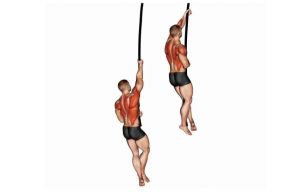
Numerous body muscles are used during rope climbing, including the back, core, and muscles in the arms, legs, quadriceps, hamstrings, and gastrocnemius. As a result, sessions are designed to address multiple areas at once in order to support the mental and physical development of the client.
2. Enhanced Grip Strength and Coordination:
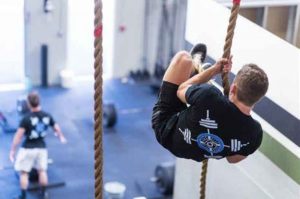
Regular rope climbing strengthens the grip muscles, which in turn leads to stronger hands and forearms. Additionally, mastering different climbing techniques requires upper- and lower-body coordination, which improves motor skills and coordination efficiency.
3. Improved Overall Fitness:

In addition to building strength, rope climbing improves cardiovascular health by raising your heart rate. As a result, it provides the ideal balance of cardiovascular and muscular fitness, increasing your body’s strength and endurance.
4. Easy to Add to Your Routine:
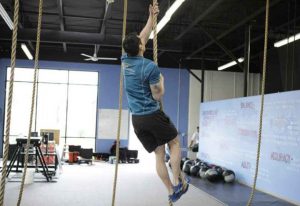
Rope climbing is a great addition to any workout routine. Whether you incorporate this exercise into a circuit or use it as a stand-alone workout is up to you; the important thing is that it adds some variety to your routines.
5. Feeling Accomplished and Confident:

Reaching the summit of a rope climb is the ultimate achievement. It boosts your confidence and gives you a sense of accomplishment. One tangible benefit of climbing mountains is that you become stronger and more fit with each summit you reach.
Essential Items for Rope Climbing:
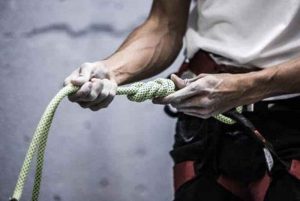
- Gym Chalk: Prevents you from touching the wet. Make Rogue Gym Chalk your dependable option.
- Liquid Grip: Ideal for people who prefer not to reapply chalk frequently, it provides a moisture-free hold with just one application.
- Climbing Ropes: For a safe climb, choose sturdy ropes like the Rogue Manila Climbing Ropes.
- Climbing Shoes: Invest in a pair of lightweight, cosy shoes with supportive cushioning, like the Reebok Nano Classic.
Always remember that safety comes first! Always learn how to attach your rope correctly to prevent accidents and injuries.
Important Tips for Rope Climbing:
Start with Sitting Practice:
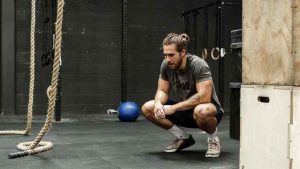
To get into the beam, start by sitting on a box. Then, use a J-hook or Spanish wrap to raise yourself to a standing position. You can practise maintaining pressure on the rope and getting back up before attempting to accomplish this.
Use a Jump to Get Higher:
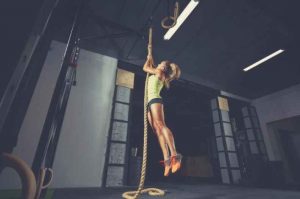
Leap off the ground to give yourself a boost before starting to stand up. This is advantageous to you because it takes you higher and facilitates a quicker and easier ascent. Additionally, knee sleeves, shin guards, and long socks may help with that issue.
Opt for Suitable Footwear:
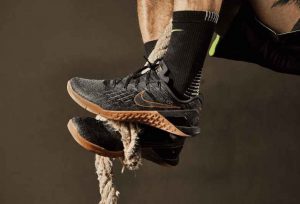
For rope climbing, choose cross-trainers rather than running shoes because they offer greater protection and support. It’s advisable to wear footwear intended for the sport instead of trail shoes because they often rip off when climbing.
Control Descent with Your Feet:
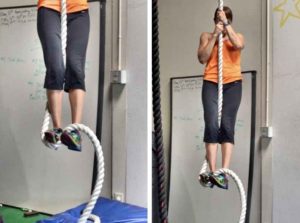
You will abrasion your hands if you slide down the line like a fire pole. Instead, stay off of the slip-and-slide. Instead, use your feet to your advantage and descend with grace, descending slowly and deliberately.
With a little practice and adherence to these tips, you should soon be able to climb the rope independently and with little difficulty.
Rope climbing technique:
The J-Hook Technique:
- Step Next to the Rope: To begin, move up next to the rope.
- Grab the Rope: Hold the rope over your head with both hands, being careful to maintain a straight arm position.
- Pull Up Your Knees: Bend slightly back while bringing your knees up to your elbows.
- Make the J-Hook: Form a hook by encircling one foot with the rope in a J shape.
- Step Up: Place your second foot on the rope and raise yourself to your maximum height.
- Repeat: In order to climb higher, continue in this manner while switching your feet.
The Spanish Warp Technique:
- Grip the Rope: Maintain a straight-arm posture while holding the rope above your head with both hands.
- Lift Your Legs: Draw yourself nearer to your feet by bending your knees.
- Cross Your Legs: Spread one foot out and cross your legs at the ankles.
- Wrap the Rope: Only wrap the rope once around the lower leg.
- Step Up: To begin, stand on the rope with your foot inside your crossed legs.
- Change Legs: Repeat stepping on the rope with the other leg, but this time, change which foot goes on the rope.
- Ascend: Continue progressively moving upward, spreading your legs wide and repeating as necessary to reach higher altitudes.
Pro Tip: Advance to “legless” climbing once you’re comfortable. Learn the fundamentals first, move on, and always put safety first by employing safety gear and appropriate techniques. Cheers to your ascent!
In summary, mastering the art of rope climbing requires dedication, practice, and attention to detail. By starting with sitting exercises and increasing the jumps to get higher, you can succeed more quickly and gain confidence. For both comfort and safety, choosing the appropriate shoes and controlling your descent with your feet are essential.
So, this was all about pro Rope Climbing tips, techniques, and more. Also read, Anushka Sharma & Virat Kohli’s second baby to be born in London?

